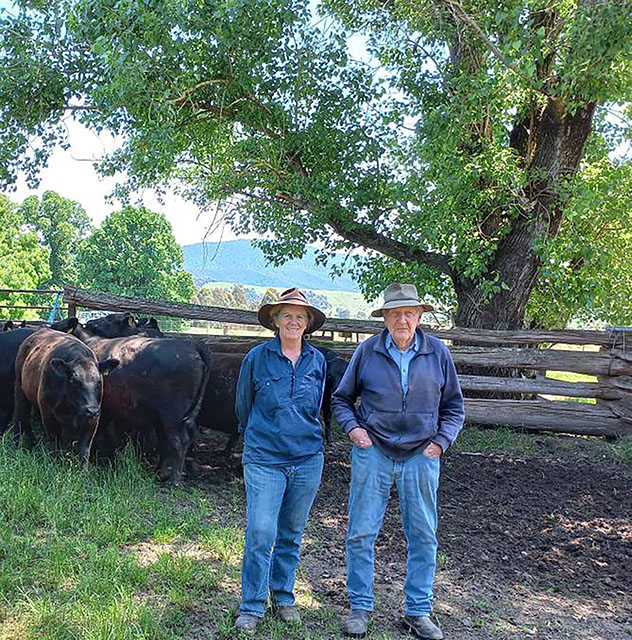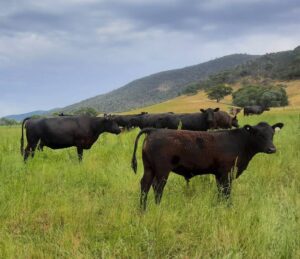Quality Angus genetics thrive in tough alpine winters


The Carroll family have been running quality Angus cattle for more than 50 years with a focus on breeding easy-doing, productive cows which thrive in the tough conditions of Victoria’s high country.
Loretta Carroll, her 94 year-old father James, and sister Margaret and her husband Clyde, are all involved in the family operation, which trades as J & SA Carroll Family Trust, comprising about 220 Angus breeders.
Ms Carroll also runs 130 Angus breeders across 244 hectares of owned and leased land along with a flock of 400 Australian White ewes including 75 stud ewes for her recently established Mudgegonga Australian White stud.
Continuing the tradition, her nephew Jordan Carroll is completing an on-farm apprenticeship, while niece Marian Joseph works closely with Ms Carroll on her property, taking a keen interest in estimated breeding values and Lambplan.
A passionate advocate for the beef industry and her local community, Ms Carroll was awarded an Order of Australia (AM) in 2021 for service to the livestock industry and the community.
The Carroll family have always run Angus and continue to be pleased with the breed’s performance and market versatility.
 “The Angus breed has proven it’s worth for us over the years,” Ms Carroll said. “They are good-doing cattle and give us the flexibility to sell them as weaners or grow them out.
“The Angus breed has proven it’s worth for us over the years,” Ms Carroll said. “They are good-doing cattle and give us the flexibility to sell them as weaners or grow them out.
“They offer plenty of market options and make a nice, even line of calves.”
In the past, the family marketed their steers directly to feedlots, but more recently they have made the change to selling weaners for ease of management.
“We used to grow them out and sell them to feedlots, then we moved to selling them at 10 to 11 months either direct on-farm or to operators such as Hopkins River Beef near Hamilton in January and February,” Ms Carroll said.
“Selling them earlier as weaners is certainly easier. If you have to grow them out to 460 to 500 kilograms live weight you have to carry them through another winter and really look after them.”
On bull selection Ms Carroll prefers to select bulls using a visual appraisal and then look at their estimated breeding values to inform her final decision.
“The phenotype visual structure is most important for us. My Dad and I look for length of body which is where you get your quantity of meat cuts and length from hip to tail,” Ms Carroll said.
“My Grandfather always liked to see plenty of length of neck as well, in other words a good stretchy bull that almost looks like he has an extra rib or two.”
Significant emphasis is also placed on structural soundness, particularly feet and legs.
“Good hoof shape and structure, and heel and pastern, is extremely important in our climate and wet winters,” she said.
As far as EBVs go, Ms Carroll looks for average to above breed average 200- and 400-day growth rates, along with a moderate birth weight and gestation length.
Low birth weight bulls are selected for the heifers only.
“We don’t want to compromise calving ability, so we generally look for average or above birth weight to maintain the calving ease of our breeders but we don’t want to push the birth weight too low,” she said.
“We also consider carcase traits, including eye muscle area, and milk EBVs.”
All the cows are joined on June 1 to start calving in mid-March, but Ms Carroll is considering moving the breeding program two weeks earlier to maximise the calves’ weight gain and maturity ahead of the weaner sales.
Current conception rates consistently average about 95 per cent.
The calves are weaned in early December and supplemented with silage in good quality pasture paddocks to help quieten them down.
Although Ms Carroll has tried a range of different weaning programs, she said they have the most success simply weaning the calves over the fence from their mothers.
“I prefer to have them in the yards for minimal time to lessen the risk of pink eye,” she said.
“Weaning them alongside their mothers also means they settle down quicker.”
In 2020, the Carroll family marketed their weaners through the saleyards for the first time, selling their draft of calves at the special calf sale in Myrtleford held by Nutrien Ag Solutions Ivone Agencies in mid-December.
“At the 2021 sale, my Dad’s steers averaged 348kg, with his first pen of 22 calves averaging 390kg, making $2400,” Ms Carroll said.
“Mine are always a little under his and last year averaged 338kg making an average of $2370 with the top 24 head making $2400.”
At the recent December sale, Ms Carroll sold 63 steers and heifers, holding back some of the lighter calves. She said the effects of an extremely wet winter did result in lighter calves this year.
“The steers averaged 310kg with the tops reaching $1830 at 316kg while my father’s steers averaged 337kg with his first pen of 22 calves weighing 383kg and selling for $1975,” Ms Carroll said.
“The sale as expected was down on last year’s extreme highs but held up well on the day in comparison to other sales across the state, so we were pleased overall.”
Across both properties about 90 heifers are retained each year. Selection emphasis is focused on structure, weight for age, frame size and good length and depth of body.
A flexible grazing rotation is employed with the pastures monitored regularly and the cattle moved as required.
During winter, the cattle are supplemented with silage and straw for roughage. Magnesium, copper and selenium lick blocks and salt are also supplied.
Ms Carroll has replaced the use of synthetic fertiliser with a custom biological product from Hybrid-Ag.
The product, TSM200, contains a mixture of lime, gypsum, soft rock phosphate and trace elements, which she said has significantly improved soil health, biology, water infiltration and holding capacity as well as overall cattle health.
“Soil tests show that aluminum levels have reduced, the pH is increasing, and it has also lifted pasture growth and diversity.”
Kylie Nicholls, The Land